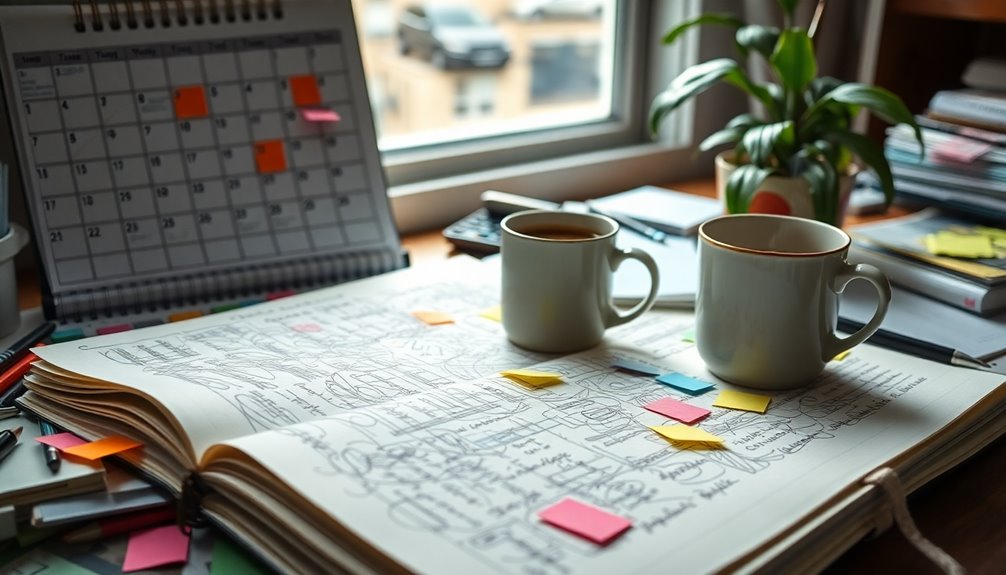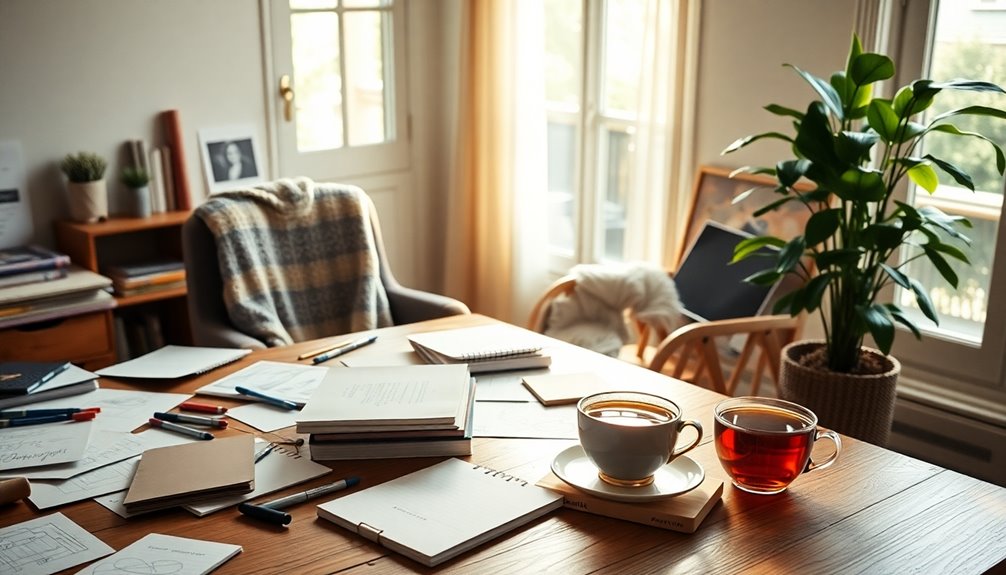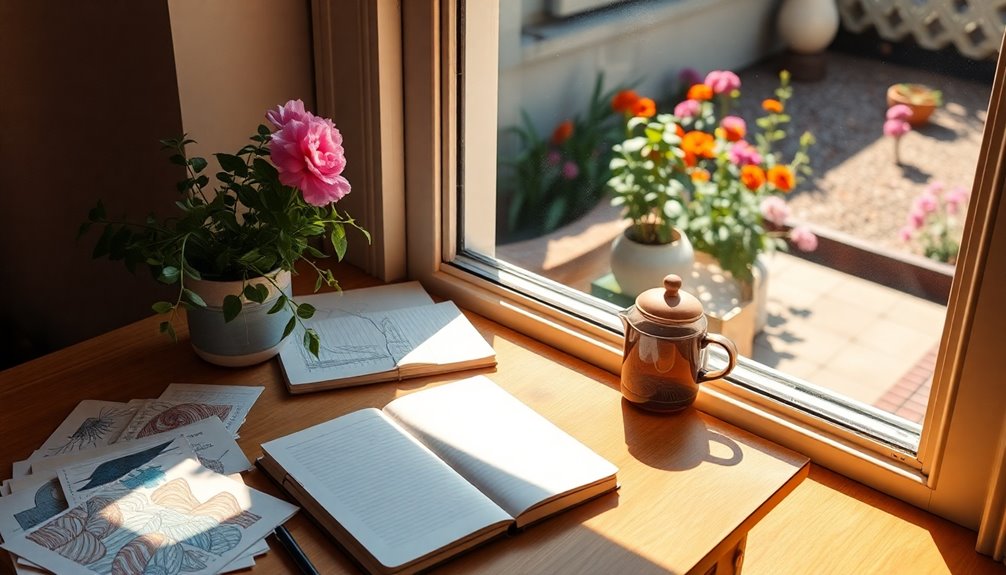Creative overwhelm can be intimidating, but you can manage it effectively. Start by recognizing your emotional triggers and setting realistic goals. Break your ideas into smaller tasks to maintain focus. Implement time blocks to structure your creative sessions, and don't forget to take breaks—these are essential for recharging your mind. Reflect on your progress regularly and balance quantity with quality to maintain your artistic integrity. Remember, it's okay to step back when needed. This approach can make your creative journey smoother, and there's more to explore on how to keep your inspiration flowing without burnout.
Understanding Creative Overwhelm
When you plunge into the world of creativity, it's easy to feel overwhelmed by the sheer volume of ideas and possibilities. This creative block often stems from emotional triggers and the pressure to generate innovative concepts.
To navigate this chaos, focus on mindset shifts that promote artistic flow. Identify your inspiration sources, whether they're nature, music, or conversations. Implement motivation techniques like setting small goals or creating a routine. Recognizing that happiness is a choice can also help foster a more positive mindset during creative endeavors. Remember that overcoming obstacles is crucial for maintaining your creative momentum.
Prioritize self-care practices to enhance your mental clarity and manage stress. Remember, idea generation isn't a race; it's a journey. Embrace the ebb and flow of creativity, allowing yourself the space to breathe and explore without judgment. Developing coping strategies can also help mitigate feelings of overwhelm and foster a more sustainable creative process.
Recognizing Your Triggers
Creative overwhelm can often mask deeper emotional triggers that hinder your artistic expression. To tackle this, start with triggers identification. Pay attention to what situations or feelings spark your stress signals.
Are you overwhelmed when deadlines approach or when comparing your work to others'? Recognizing these patterns can provide insight into your creative blocks. Engaging in outdoor activities can also help refresh your mind and alleviate some of the pressure you feel.
Journaling your thoughts can help you pinpoint these triggers more effectively. Notice when you feel anxious or discouraged; these stress signals often indicate underlying issues. Practicing mindfulness and present moment awareness can further enhance your ability to manage these stress responses and foster a calmer creative process. Additionally, incorporating healthy lifestyle choices such as regular exercise can significantly reduce stress levels and improve overall emotional well-being.
Setting Realistic Goals

To manage your creative overwhelm, you need to set realistic goals.
Start by defining clear objectives, breaking tasks down into manageable steps, and prioritizing what truly matters. This approach will keep you focused and help you make steady progress. Additionally, incorporating time management techniques can further enhance your productivity and organization. Regularly reviewing your goals to ensure they remain relevant is a crucial part of prioritization and goal setting. Furthermore, establishing specific deadlines for your objectives will create a sense of urgency and accountability in your work.
Define Clear Objectives
Setting realistic goals is essential for managing creative overwhelm, as it provides a clear roadmap for your efforts.
To achieve goal clarity, identify what you want to accomplish within a specific timeframe. Break your larger ambitions into smaller, manageable objectives that are achievable and measurable.
This objective alignment helps you stay focused and motivated, reducing the likelihood of feeling overwhelmed. Regularly assess your progress and adjust your objectives as needed to guarantee they remain relevant and attainable.
By defining clear objectives, you'll not only enhance your productivity but also maintain your enthusiasm for your creative projects.
Break Tasks Down
Break tasks down into smaller, more manageable steps, and you'll find it easier to tackle even the most intimidating projects. By setting realistic goals, you create a clear path forward.
Here are some strategies to explore:
- Use structured outlines to guide your process
- Set manageable milestones to track your incremental progress
- Engage in focused brainstorming sessions for clarity
- Embrace task delegation to lighten your load
- Establish creative schedules to maintain momentum
These techniques foster simplified workflows and enhance collaborative efforts.
When projects feel overwhelming, remember that breaking them down allows for steady, consistent progress. With each small step, you'll gain confidence, making the overall task feel much more achievable.
Prioritize Essential Activities
While juggling multiple creative projects, it's essential to prioritize crucial activities that align with your goals. Start by conducting an essential activities assessment to identify what truly matters.
Use task prioritization techniques like the Eisenhower Matrix or ABCD method to distinguish between urgent and important tasks. Focus on activities that advance your project and reflect your vision.
By setting realistic goals, you'll prevent overwhelm and maintain momentum. Break larger tasks into manageable steps, and tackle them one at a time.
Remember, it's better to finish a few key projects well than to spread yourself too thin. Regularly revisit your priorities to adapt to any changes and keep your creative energy flowing.
Stay mindful, and you'll thrive!
Prioritizing Your Ideas
To prioritize your ideas effectively, start by identifying the core concepts that resonate most with you. Once you've pinpointed these key themes, set clear goals that align with your vision. Additionally, creating a structured routine can enhance your time management skills, ensuring that you dedicate adequate time to each idea. Establishing SMART goals can provide a clear framework for your creative process and help you stay focused. Finally, organize your ideas by importance to guarantee you're focusing your energy where it matters most. Incorporating mindfulness practices can help you maintain focus and clarity throughout this process.
Identify Core Concepts
Identifying core concepts is essential when you're feeling overwhelmed by creative ideas. By honing in on what truly matters, you can align your creative flow with your core values.
This focused approach helps you cut through the noise and prioritize effectively. Here are some strategies to help:
- Reflect on your core values.
- List your top three ideas.
- Assess which ideas resonate most with your vision.
- Eliminate less relevant concepts.
- Seek feedback from trusted peers.
Set Clear Goals
Setting clear goals is essential for transforming your creative ideas into actionable steps. Start by practicing goal visualization; picture what success looks like for each idea.
Break your larger vision into smaller, manageable tasks to achieve incremental progress. This way, you won't feel overwhelmed by the enormity of your projects. Instead, you'll focus on completing one task at a time, which keeps your motivation high.
Write down your goals and track your progress regularly; this not only clarifies your path but also reinforces your commitment.
Organize by Importance
While juggling multiple creative ideas can be exciting, prioritizing them is essential to prevent feeling overwhelmed.
Effective idea management helps you maintain your creative flow and focus on what truly matters. Here are some quick tips to organize your ideas by importance:
- Identify your goals: Align ideas with your objectives.
- Evaluate impact: Determine which ideas will create the most value.
- Consider timing: Assess deadlines and immediate needs.
- Seek feedback: Get input from trusted peers to gauge importance.
- Stay flexible: Be ready to adjust priorities as needed.
Implementing Time Blocks

To effectively manage creative overwhelm, implementing time blocks can be a game-changer. Time management becomes easier when you allocate specific periods for tasks. Start by identifying your peak productivity times, then create a schedule that reflects your energy levels. Use creative scheduling to set aside uninterrupted blocks for brainstorming, writing, or editing. This focused approach helps maintain clarity and prevents burnout. Engaging in mindfulness practices during your time blocks can significantly enhance task effectiveness and keep you centered. Additionally, limiting distractions like social media and email notifications can further enhance your productivity during these focused sessions. Incorporating deep breathing techniques can help reduce stress and improve focus during these creative periods. Don't forget to include breaks to recharge your mind; they're essential for sustaining creativity. You might also want to limit distractions during these blocks, ensuring your environment supports your work.
Embracing the Pomodoro Technique
When you feel creativity slipping away under the weight of your tasks, embracing the Pomodoro Technique can provide the structure you need.
This time management method helps you stay focused while reaping numerous Pomodoro benefits, like:
- Improved concentration
- Reduced mental fatigue
- Enhanced creativity
- Increased productivity
- Better work-life balance
Creating a Safe Space

Creating a safe space for your creativity is crucial, especially in a world filled with distractions and pressure. To foster your imagination, you need to establish creative environments that feel welcoming and free from judgment.
Start by setting safe boundaries—both physical and mental. Choose a designated area where you can express yourself without interruptions. Limit outside influences by turning off notifications or putting on headphones.
Surround yourself with inspiring materials, whether it's art, books, or plants. It's essential to protect this space, allowing your thoughts to flow freely.
Fostering Mindfulness Practices
Mindfulness practices can greatly enhance your creative process, as they help you stay present and focused. By incorporating these techniques into your routine, you can manage overwhelm more effectively:
- Mindful breathing to center your thoughts
- Creative journaling for self-expression
- Gratitude practice to shift your mindset
- Visualization techniques to clarify your goals
- Nature immersion to spark inspiration
Engaging in meditation exercises can calm your mind, while mindful movement reconnects you with your body.
Consider a digital detox to minimize distractions, allowing for deeper sensory awareness.
Finally, practice intention setting to align your creative efforts with your true desires.
Embracing these practices can foster a more balanced and inspired creative journey.
Limiting Distractions

As distractions can easily derail your creative flow, it's essential to establish boundaries that protect your focus.
Start by creating a distraction-free environment; declutter your workspace and embrace a minimalism approach. Engage in mindful consumption by limiting your digital devices during creative sessions.
Consider a digital detox to reduce interruptions and boost your productivity. Implement focus techniques, like the Pomodoro method, to maintain concentration while taking intentional breaks to recharge.
Set clear technology boundaries, silencing notifications and designating specific times for checking messages.
By prioritizing distraction management, you'll find it easier to harness your creativity without feeling overwhelmed.
Seeking Feedback Wisely
When you seek feedback, it's essential to choose the right audience who understands your vision.
Timing your requests can make a big difference, as feedback can vary based on when you ask for it.
Finally, focus on gathering constructive input rather than destructive criticism to help your creativity flourish.
Choosing the Right Audience
How do you determine which audience will provide the most valuable feedback for your creative work?
Start by identifying your target audience through demographic research and audience personas.
Consider these key factors:
- Content relevance to their interests
- Engagement metrics from previous interactions
- Potential for audience engagement
- Fit within niche markets
- Preferred feedback channels
Timing Your Requests
Timing your requests for feedback can greatly impact the quality and usefulness of the responses you receive. To maximize your insights, employ effective timing techniques. For instance, ask for feedback after completing a draft but before extensive revisions; this way, you'll capture fresh perspectives while your ideas are still vibrant.
Use request strategies that consider your audience's availability and expertise. If you know someone's busy, wait for a more suitable moment to approach them.
Additionally, consider the project's stage; early feedback can guide direction, while later input can refine details. By aligning your requests with the right timing, you'll foster productive conversations and receive valuable insights, ultimately enhancing your creative process.
Constructive vs. Destructive Input
Feedback can be a double-edged sword, and knowing the difference between constructive and destructive input is essential for your creative journey. Embrace constructive criticism that fosters a growth mindset, while steering clear of toxic influences that promote a fixed mindset.
Seek out supportive environments where positive reinforcement thrives.
- Understand the importance of critical analysis.
- Identify destructive feedback that stifles creativity.
- Engage in creative collaboration for diverse perspectives.
- Filter negative input to protect your vision.
- Cultivate relationships that encourage growth.
Taking Breaks Effectively

When should you take a break to recharge your creativity? It's important to recognize the signs of burnout—like fatigue or a lack of inspiration.
Implement mindful pauses throughout your day to refocus your thoughts. These short breaks can help you reset without losing momentum.
Additionally, consider scheduling rejuvenating retreats, whether it's a weekend getaway or a quiet day at home. These longer breaks allow you to step away from your work entirely, giving your mind the space to breathe and rejuvenate.
Use this time to engage in activities that spark joy or curiosity.
Reflecting on Your Progress
As you take a moment to reflect on your progress, you'll gain valuable insights into your creative journey.
This progress reflection is essential for understanding where you stand and where you want to go. Conducting an achievement assessment can help clarify your goals and priorities.
Consider these points during your reflection:
- Identify key milestones you've reached
- Acknowledge challenges you've overcome
- Recognize skills you've developed
- Evaluate feedback received from others
- Set future intentions based on your insights
Balancing Quantity and Quality

While it's tempting to focus solely on producing a high volume of creative work, finding the right balance between quantity and quality is essential for your growth.
Implementing quality assurance and quantity control helps you maintain artistic integrity while fostering a productive workflow. Aim for a creative balance by emphasizing idea refinement over sheer output.
Set your expression limits to avoid burnout and guarantee your work resonates. Utilize content curation and feedback loops to enhance your projects, making them more impactful.
An effective execution strategy involves understanding when to push for more and when to hone in on quality. Ultimately, it's about creating work that not only fills your portfolio but also speaks to your audience.
Knowing When to Step Back
Sometimes, you mightn't realize you're heading toward creative burnout until it's too late.
It's essential to recognize when your enthusiasm starts to wane and set healthy boundaries to protect your creative energy.
Knowing when to step back can rejuvenate your inspiration and keep your creativity flowing.
Recognizing Creative Burnout
How can you tell when your creative spark has dimmed? Recognizing creative burnout is essential to regaining your passion. Look for these signs:
- Persistent creative fatigue
- Emotional exhaustion or lack of motivation
- Loss of inspiration and diminished enthusiasm
- Physical symptoms like headaches or fatigue
- Mental blocks and negative self-talk
When you feel overwhelmed by perfectionism pressure and self-doubt struggles, it's time to step back.
Isolation feelings often creep in, magnifying overwhelming expectations. If you notice these shifts, don't ignore them.
Acknowledging these signs can help you address your creative burnout before it spirals further.
Setting Healthy Boundaries
Recognizing the signs of creative burnout is just the first step; the next is setting healthy boundaries to protect your creative energy.
Start by identifying different boundary types, including social, emotional, and professional boundaries. Clearly communicate your personal limits to others and practice boundary enforcement to guarantee they're respected.
Remember, boundary flexibility can be beneficial; adjust your limits when necessary, but be aware of boundary consequences if you overextend yourself. Reinforce your boundaries consistently to maintain your well-being.
It's crucial to engage in boundary communication, expressing your needs without guilt. By effectively managing your boundaries, you'll safeguard your creativity and foster a healthier, more sustainable approach to your artistic endeavors.
Conclusion
In managing creative overwhelm, remember that it's okay to slow down. By recognizing your triggers and setting realistic goals, you can harness your creativity without feeling swamped. Taking breaks and reflecting on your progress helps maintain a balance between quantity and quality. So, ask yourself: isn't creativity meant to inspire joy, not stress? Embrace the process, prioritize what truly matters, and you'll find a fulfilling path forward that honors both your ideas and your well-being.



